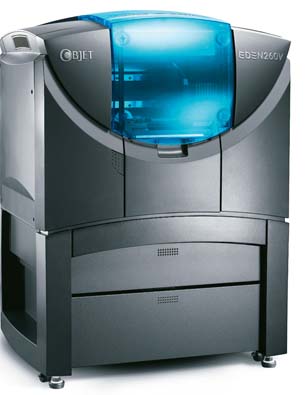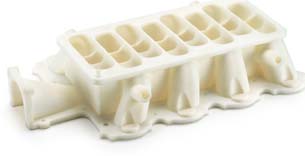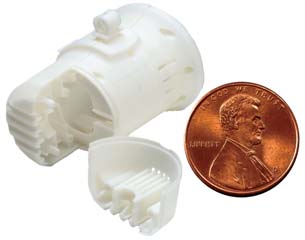Get a Rapid ROI
What gets the job done most efficiently and cost effectively in rapid manufacturing may be more important than sticker price.
Latest News
November 1, 2010
By Susan Smith
 The Objet Eden reduced approximately 20% of ADMTronics’ design cost in getting its part readied for a clinical trial. |
Rapid prototyping and manufacturing costs are generally calculated in terms of how much the equipment costs, minus how much time and money is saved with the equipment, and what option is chosen—whether it be to purchase 3D printers, systems platforms or to use service providers. Other benefits include being able to make several iterations of a prototype until you arrive at the right design in-house, rather than outsourcing and possibly not being part of the whole prototyping process.
The costs of rapid prototyping and manufacturing are commensurate with what value your organization can derive from the investment. Is a low cost 3D printer what you need, or do you need to go with a higher end selective laser sintering (SLS) or 3D system to meet your manufacturing needs? Would your organization prefer to try a service provider first to see what processes work best, then invest in your own equipment?
Low-Cost Options
Organizations need to determine if they want to do prototyping or whether they want to create end-use parts or products. Many low-cost 3D printers are capable of producing good, accurate prototypes. Multi-material machines from Objet Geometries can enable customers to create prototypes using numerous materials that have the look and feel of the finished product. Some customers find they want to do manufacturing of end use parts, and can justify the cost of higher end machines. Prototyping requirements for some organizations are very specific, such as those in the medical or aerospace industries.
The number one way to keep costs down in manufacturing is to perfect your design with prototyping before going to tooling, to reduce tooling rework, according to Joe Hiemenz, technical communications and public relations manager at Stratasys Inc. In terms of manufacturing, you want to be able to eliminate tooling altogether.
The low cost of some 3D printers have made them attractive to other industries such as architecture and art. Some models come in the $14,000 to $24,000 range, such as two new machines recently introduced by Z Corp. at an entry-level price point: the ZPrinter 150 (monochrome, $14,900) and ZPrinter 250 (multicolor, $24,900). These machines have a small physical footprint that is suited for the classroom, department, or small business, but are not aimed at manufacturing.
In the low-medium price range is the new ZBuilder Ultra ($34,000) ranging upward through the Objet ($100,000 to $240,000) to the high end Stratasys fused deposition modeling (FDM) ($250,000 to $350,000) and EOS’ $250,000 to $850,000 laser sintering (LS) offering.
 A manifold created with a Dimension 3D printer.A contractor for the Missouri National Guard reported they saved enough money to pay for their Dimension 3D printer, which is priced around $30,000. |
Measuring ROI
Measuring return on investment can be a no-mans-land for some customers, but can be quantified by greater accuracy, time savings and production costs. One way of looking at ROI is that a penny over the purchase price is technically how ROI is calculated. Once you make your money back after purchase of the machine, you make one cent of return. But this is not counting the cost of materials. Another perspective is that once you have made a purchase, from that time on you stand to save money as the use of the machine is helping to save from that day forward. Costs are probably easier to calculate if the rapid prototyping is outsourced.
Hiemenz says the quickest way to measure ROI after purchase of a 3D production machine is to manufacture assembly jigs and fixtures on it, because it cuts out machining and tooling which saves weeks or months of work.
“You’re going to save 50 to 99% in production costs, typically more like 70 to 90%,” he says. “In the manufacturing world, if you can save 5 or 10% you’re pretty happy.”
Customers can save the same amount in production costs by making jigs and fixtures with their Dimension 3D printers. Di Mino says they can use Objet Eden to create tools such as jigs and fixtures for their own use in the manufacture of the devices.
Rapid Manufacturing Bureaus at Your Service One way customers can get rapid manufactured parts built without owning their equipment is to first use a service bureau, which maintains the latest in machines and materials, and can advise which ones will work best for their needs. Service providers can address customers who wouldn’t otherwise be able to afford to buy their higher end systems. Joe Hiemenz, public relations manager at Stratasys, says some of these customers later purchase 3D printers or high end machines for their own organizations. But many come to rapid technologies to have more control over their design process, and to accomplish in prototyping or manufacturing, what cannot be done with machining, tooling or injection molding. Maintaining machines and materials in-house allows them to produce volumes of products in their own timeframe, without having to wait for them to be completed by a service provider. Potential customers can research vendors who offer different machines, or visit customers who are using them successfully to see what might work for them. A lower cost machine might be a good starting point for a new customer. |
“I’ve seen it (ROI) as little as one project,” says Hiemenz. “On a Dimension 3D machine, a contractor for the Missouri National Guard made 40 camera mounts for armored tanks, a manufactured end-use product.” They reported they saved enough money to pay for their Dimension, which is priced around $30,000.
At Sheppard Air Force Base in Wichita Falls, TX, the Trainer Development Flight (TDF) is a facility that designs, develops and manufactures trainers and training aids for the Air Force and all branches of the Department of the Defense (DoD). These products are either original products or replicas of existing ones. One of their designs is an exact replica of a UAV for training repair technicians. The TDF uses four Stratasys Fortus machines. For just the production of the UAV’s large antenna, for example, the company reported that it took one-tenth the time that it would have taken to accomplish with conventional methods, with an ROI of more than $12,000.
Mitchell Weatherly, chief of the TDF said “for our first FDM machine purchase, we projected ROI in four years, but it took only 18 months. For our second FDM machine purchase, we saw ROI in only nine months.”
The cost of the four machines that TDF purchased was approximately $350,000 each.
Stratasys Fortus 3D Production systems range from $90,000 to $450,000. Their Dimension 3D Printers range from $15,000 to $35,000.
Intangible Benefits
Andre DiMino, executive vice president and CTO of ADMTronics (formerly Ivivi Technologies) says not all value in rapid prototyping can be quantified. For example, on one project they calculated that the Objet Eden reduced approximately 20% of their design cost in getting the part readied for a clinical trial.
“As far as costing, that was 20%, but there was more like a 40% reduction in time, which was even more valuable to us,” says Di Mino.
DiMino says ADMTronics develops, designs and manufactures medical electronic equipment with some ergonomic functions using Objet’s technologies. They work mostly with non-invasive electrotherapies such as nerve stimulators and ultrasound devices.
With previous processes, DiMino says the company used stereolithography combined with getting molds made and sculpting in clay. The molds had to be sent out to a service bureau.
“Being able to draw the units, producing them in our Objet Eden 350 machine and having that piece be right to install the electronics has cut months off the process,” says DiMino. “It also allows us to try many different things, print them on the printer, install the electronics, and physically see it operating within days, which we wouldn’t be able to do with previous processes because it would take so long to do different variations.”
Medical devices must go through clinical trials, and DiMino pointed out that you want to put the product into the clinical trial that is as close to the finished production piece as possible.
“We will print out 40 to 100 units for clinical trials, which keeps us from having to make an actual finished mold for the clinical trial,” DiMino says. “Once the clinical trial is done, it gives us some feedback as to whether changes are needed before we go into the actual expense of molds. We’re actually able to change the ergonomics before we go into making a final mold.”
Object’s high-end Eden 3-Dimensional Printing Systems offer printing with the accuracy of 16µ layers, and all Eden systems produce models with very fine details and smooth surfaces. The Eden 350 and 260V are similar in nature with only a difference in bed size. The 260V is the same as their 500V with only a different bed size, and retains all the features and functions but at a lesser price.
The Eden260V costs approximately $100,000. A Connex costs approximately $240,000.
The ability to make parts with different facets that could not be machine cut or injection molded is a real plus that is hard to calculate in terms of time savings. EOS points out that Northwest UAV Propulsion Systems (NWUAV), an aerospace provider, is now able to make parts with multiple angles that couldn’t be machine cut.
Unmanned vehicle craft are very weight sensitive and require a lot of design iterations, and new functionality for which EOS’ laser sintering (LS) process works well. Lightweight nylon parts are required for ducting and shrouding as well as fuel tanks and a part can be designed with a unique shape to fit a complex space with many interfaces.
According to Alex Dick, of Northwest Rapid Manufacturing, which is part of the Northwest UAV family of companies, from a production standpoint, “we’re most often using the latest sintering process to make shrouds that direct cool air over the engine ribs, and the top of the engine to make sure it’s staying cool enough. That’s a three- or four- part assembly with different LS parts.
 Perfecting your design with prototyping before going to tooling reduces tooling rework. |
“The laser sintering process also gives us a large flexibility in the volumes that are produced. We can produce a single part, or we can produce several hundred parts quickly and cost effectively dependent on part size,” says Dick. “You can fit a lot of features and functionality, holding reasonable tolerances, etc. with parts with x/y/z dimensions of 4 to 6 in. Too small or too large and the tolerances fall off but there are good applications on both ends of the part-size spectrum (0.030 in. minimum to 28 in. maximum in a single piece).”
NWRapid Manufacturing does all the component production for laser-sintered parts. NWUAV is doing all the assembly, and handling the whole engine subsystem, which includes the controller cards and propeller and everything in between.
“As compared to other additive technologies, with laser sintering there are time and labor savings because there is no support creation or removal process,” says Dick. “Parts can be nested for increased productivity. Compared to conventional technology, high-complexity, low-volume parts can be created without costly molds or assembly.”
Dick said that for the quantity and complexity and frequency of design changes, “I don’t see another solution.”
NWUAV initially started additive manufacturing with the EOSINT P390 system (currently priced at around $350,000) and it quickly discovered a need for increased capacity leading them to the purchase of a second system, EOS’s larger frame plastic sintering system the EOSINT P730 (currently priced at around $850,000).
With the larger build envelope of the Stratasys Fortus machine, for example, it is possible to make bigger parts in one go, and the throughput is much faster: 200 to 1,000% faster than that of Dimension 3D printers, according to the company. The 3D production machine also has higher accuracy and more options in terms of software and user control over the parameters, plus higher resolution.
More Info:
Dimension Printing
Stratasys
3D Systems
Objet Geometries, Ltd.
EOS
Z Corporation
Susan Smith has been working as an editor and writer in the technology industry for more than 16 years. She is a contributing editor for Desktop Engineering magazine. She can be reached via [email protected].
Subscribe to our FREE magazine, FREE email newsletters or both!
Latest News
About the Author
DE’s editors contribute news and new product announcements to Digital Engineering.
Press releases may be sent to them via [email protected].






